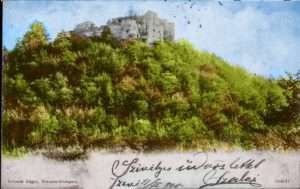Zay Ferenc (1498-1570)
Baron Csömöri Zay Ferenc, (1498 – 10 October 1570), was a distinguished diplomat, royal courtier, chief captain of Upper Hungary, and historian. We can also consider him as a member of the Valiant Order of the Hungarian Borderland.

This little-known soldier, a district captain, was born in 1498 as the son of Zay Péter and Kamarás Borbála of Lunka and Zelemér. He was educated in Padua and spoke Italian, Latin, Serbian, Croatian, and German. As a young man he took part in the battle of Mohács and in 1528 he became a royal councilor on the side of King Ferdinand.

He took part in several battles in Hungary (1532 and 1541, the attempted capture of Buda) and in Germany (e.g. the Battle of Mühlberg). In 1550 he was appointed captain of Eger Castle alongside Dobó István, but was soon transferred to Szolnok to build a fortress at the confluence of the Zagyva and Tisza Rivers. Here is more about the castle of Szolnok:
https://www.hungarianottomanwars.com/ottoman-occupied-lands/szolnok-castle/

Zay was also appointed the chief captain of the new fortress, but when the castle fell (1552) he was no longer in office and became the chief captain of the Outer Szolnok County. In 1552 he became the captain of the boatmen of Komárom castle, a post he held until 1560.

His “bravery, skill, and outstanding mental ability” were even more evident in important public services, and in 1555 he was in the company of Verancsics Antal in Constantinople, thus rendering diplomatic service to the court in addition to military service.

On 1 July 1560, King Ferdinand rewarded his services with a baronial elevation “with his children of both genders and their descendants to the rank of barons and magnates of the country”.

In the same year, he was appointed to the position of chief captain of Kassa (Kosice, Kaschau) and Upper Hungary. This was a difficult post because the Kassa region bordered Transylvania, from where King János Zsigmond, in alliance with the Turks, could launch an attack at any time. On 4 March 1562, he defeated János Zsigmond at Hadad with Balassa Menyhárt, thus relieving the castle from the siege of the Transylvanian army. His command of Kassa (Upper Hungary) ended in 1565.

As a nobleman from southern Hungary, he was particularly affected by the fall of Nándorfehérvár (Belgrade) in 1521. This inspired him to write his famous work in Hungarian rather than Latin. He died at his estate, Zayugróc, on 10 October 1570.

His first wife was Bánffy Borbála (?-1569) of Gara, with whom he had a large dowry, and they had eight children:
- Péter (?); his wife was: Soós Katalin of Poltár
- János (?); his wife was: Kubinyi Borbála of Felsőkubiny and Nagyolasz
- László (1547–1590) was the captain of Véglesvár castle and royal chief table master; his wife was: Felizitas von Puecheim
- András (?); his wife was: Apponyi Orsolya of Nagyappony
- Magdolna (?); she was married five times
- Anna (?); her husband was: Csáky Pál of Körösszeg and Adorján
- Lőrinc (?); his wife was: Baroness Jakussith Sára of Orbova
- Borbála (?); her husband was: Petrőczy Miklós of Petrőcz and Kászavár

However, Baron Zay was widowed in 1569, so he remarried in 1566. He then married Mindszenti Katalin, with whom he had only one son:
- Miklós (1568-?); his wife was: Török Erzsébet of Pán
Here is more about Zayugróc castle: - https://www.hungarianottomanwars.com/kingdom-of-hungary/zayugroc/
His works:
- De Scepusiensis belli initio & praeludio a. 1560 (M.G. Kovachich, Scriptores rerum hungaricarum minores I. Budae, 1798. 5.)
- Levelek Heraclides Jakab moldva vajda és Zay Ferencz kassi főkapitány összeköttetéseinek történetéhez; (“Letters to the history of Zay’s connections to Voivode Heraclides Jakab of Moldova”) sajtó alá rend. Thallóczy Lajos; Athenaeum Ny., Bp., 1890
-

“The fall of Nándorfehérvár…”(a modern publication) - Az Landor feyrwar El wezessenek oka E woth Es Igy Essewth. 1535 k.; (” The fall of Nándorfehérvár and its reason”) jegyz., tan. Kovács István; hasonmás és kritikai szövegkiad.; KLTE, Debrecen, 1982 (Opera Facultatis Philosophicae Universitatis de Ludovico Kossuth nominatae)
- Zay Ferenc: János király árultatása (How King János was betrayed) / Pécsi Kis Péter: Magyarázat / Bánffy György: Második János… török császárhoz menetele; összeáll., szöveggond., Kis Péter, Magyarázat-át ford., bev., jegyz. Bessenyei József; Balassi, Bp., 1993 (Régi magyar könyvtár. Források)
-

A page from Zay’s book “The Fall of Nándorfehérvár…”
Source: Szibler Gábor and Wikipedia
Dear Readers, I can only make this content available through small donations or by selling my books or T-shirts.
If you like my writings, please feel free to support me with a coffee here:
You can check out my books on Amazon or Draft2Digital, they are available in hardcover, paperback, or ebook:
https://www.amazon.com/dp/198020490X
or at https://books2read.com/b/boYd81


My work can also be followed and supported on Patreon:


https://hungarianottomanwars.myspreadshop.com/all




